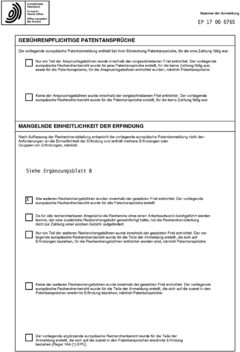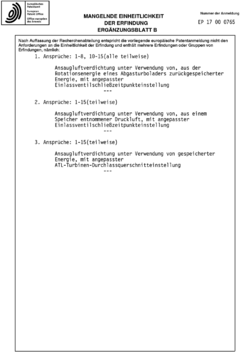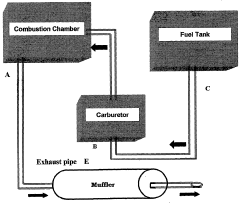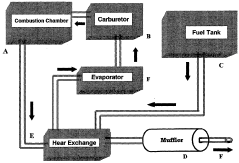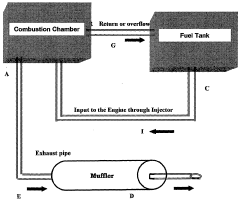V8 Engine Innovations: Fuel Consumption Reduction
JUL 4, 20259 MIN READ
Generate Your Research Report Instantly with AI Agent
Patsnap Eureka helps you evaluate technical feasibility & market potential.
V8 Engine Evolution and Efficiency Goals
The V8 engine has been a cornerstone of automotive engineering since its inception in the early 20th century. Initially designed for high-performance applications, V8 engines have evolved significantly, with a growing emphasis on fuel efficiency without compromising power. This evolution has been driven by increasing environmental concerns, stricter emissions regulations, and consumer demand for more economical vehicles.
The primary goal in V8 engine development has shifted towards achieving a balance between performance and fuel economy. Engineers have been tasking with reducing fuel consumption while maintaining or even improving the power output that V8 engines are known for. This challenge has led to numerous innovations in engine design, materials science, and combustion technology.
One of the key trends in V8 engine evolution has been the implementation of advanced fuel injection systems. Direct injection technology, for instance, has allowed for more precise fuel delivery, resulting in improved combustion efficiency and reduced fuel waste. Variable valve timing and lift systems have also played a crucial role in optimizing engine performance across different operating conditions, contributing to both power delivery and fuel economy.
Cylinder deactivation technology has emerged as another significant innovation in V8 engine development. This system allows the engine to operate on fewer cylinders during low-load conditions, substantially reducing fuel consumption during highway cruising or light urban driving. The seamless transition between full and partial cylinder operation has been a major focus of refinement in recent years.
Turbocharging and supercharging technologies have also been increasingly applied to V8 engines. These forced induction methods allow for smaller displacement engines to produce comparable power to larger naturally aspirated units, facilitating engine downsizing without sacrificing performance. This approach has been instrumental in meeting both performance expectations and efficiency goals.
Material innovations have contributed significantly to V8 engine efficiency. The use of lightweight materials such as aluminum and carbon fiber in engine construction has reduced overall vehicle weight, directly impacting fuel consumption. Additionally, advanced coatings and surface treatments have reduced friction within the engine, further enhancing efficiency.
Looking forward, the goals for V8 engine development continue to focus on pushing the boundaries of efficiency. Targets include further reductions in fuel consumption, lower emissions, and improved thermal efficiency. Integration with hybrid powertrains is becoming more common, allowing V8 engines to benefit from electrification while retaining their characteristic power and sound.
The primary goal in V8 engine development has shifted towards achieving a balance between performance and fuel economy. Engineers have been tasking with reducing fuel consumption while maintaining or even improving the power output that V8 engines are known for. This challenge has led to numerous innovations in engine design, materials science, and combustion technology.
One of the key trends in V8 engine evolution has been the implementation of advanced fuel injection systems. Direct injection technology, for instance, has allowed for more precise fuel delivery, resulting in improved combustion efficiency and reduced fuel waste. Variable valve timing and lift systems have also played a crucial role in optimizing engine performance across different operating conditions, contributing to both power delivery and fuel economy.
Cylinder deactivation technology has emerged as another significant innovation in V8 engine development. This system allows the engine to operate on fewer cylinders during low-load conditions, substantially reducing fuel consumption during highway cruising or light urban driving. The seamless transition between full and partial cylinder operation has been a major focus of refinement in recent years.
Turbocharging and supercharging technologies have also been increasingly applied to V8 engines. These forced induction methods allow for smaller displacement engines to produce comparable power to larger naturally aspirated units, facilitating engine downsizing without sacrificing performance. This approach has been instrumental in meeting both performance expectations and efficiency goals.
Material innovations have contributed significantly to V8 engine efficiency. The use of lightweight materials such as aluminum and carbon fiber in engine construction has reduced overall vehicle weight, directly impacting fuel consumption. Additionally, advanced coatings and surface treatments have reduced friction within the engine, further enhancing efficiency.
Looking forward, the goals for V8 engine development continue to focus on pushing the boundaries of efficiency. Targets include further reductions in fuel consumption, lower emissions, and improved thermal efficiency. Integration with hybrid powertrains is becoming more common, allowing V8 engines to benefit from electrification while retaining their characteristic power and sound.
Market Demand for Fuel-Efficient V8 Engines
The market demand for fuel-efficient V8 engines has been steadily increasing in recent years, driven by a combination of environmental concerns, regulatory pressures, and consumer preferences. As governments worldwide implement stricter emissions standards and fuel economy regulations, automakers are compelled to improve the efficiency of their high-performance engines, including V8s.
In the luxury and performance vehicle segments, where V8 engines are most prevalent, there is a growing demand for vehicles that offer both power and fuel efficiency. Consumers in these segments are increasingly environmentally conscious but still desire the performance characteristics associated with V8 engines. This has created a significant market opportunity for manufacturers who can deliver fuel-efficient V8 engines without compromising on power and performance.
The commercial vehicle sector, particularly in heavy-duty trucks and large SUVs, also shows a strong demand for more fuel-efficient V8 engines. Fleet operators and businesses are looking to reduce their fuel costs and carbon footprint while maintaining the power and torque required for their operations. This has led to increased interest in advanced V8 engine technologies that can deliver improved fuel economy.
Market research indicates that the global market for V8 engines is expected to grow, with a particular emphasis on fuel-efficient variants. The automotive industry is witnessing a shift towards electrification, but there remains a substantial market for internal combustion engines, especially in regions where electric vehicle infrastructure is still developing.
The demand for fuel-efficient V8 engines is not limited to new vehicles. There is also a growing aftermarket for retrofitting and upgrading existing V8 engines to improve their fuel efficiency. This trend is particularly strong among classic car enthusiasts and owners of older high-performance vehicles who wish to reduce their fuel consumption without sacrificing the character of their vehicles.
In the motorsport industry, there is an increasing focus on fuel efficiency in racing series that utilize V8 engines. This has led to the development of highly advanced fuel-efficient V8 technologies that often trickle down to production vehicles, further driving market demand for these innovations.
The marine and aviation sectors also contribute to the demand for fuel-efficient V8 engines, as these industries seek to reduce operational costs and meet increasingly stringent environmental regulations. Boat manufacturers and small aircraft producers are actively seeking more efficient V8 engine options to meet customer demands for lower fuel consumption and extended range.
As the automotive industry continues to evolve, the market for fuel-efficient V8 engines represents a critical segment that bridges the gap between traditional high-performance powertrains and future propulsion technologies. Manufacturers who can successfully innovate in this space are likely to capture significant market share and maintain relevance in an increasingly efficiency-focused automotive landscape.
In the luxury and performance vehicle segments, where V8 engines are most prevalent, there is a growing demand for vehicles that offer both power and fuel efficiency. Consumers in these segments are increasingly environmentally conscious but still desire the performance characteristics associated with V8 engines. This has created a significant market opportunity for manufacturers who can deliver fuel-efficient V8 engines without compromising on power and performance.
The commercial vehicle sector, particularly in heavy-duty trucks and large SUVs, also shows a strong demand for more fuel-efficient V8 engines. Fleet operators and businesses are looking to reduce their fuel costs and carbon footprint while maintaining the power and torque required for their operations. This has led to increased interest in advanced V8 engine technologies that can deliver improved fuel economy.
Market research indicates that the global market for V8 engines is expected to grow, with a particular emphasis on fuel-efficient variants. The automotive industry is witnessing a shift towards electrification, but there remains a substantial market for internal combustion engines, especially in regions where electric vehicle infrastructure is still developing.
The demand for fuel-efficient V8 engines is not limited to new vehicles. There is also a growing aftermarket for retrofitting and upgrading existing V8 engines to improve their fuel efficiency. This trend is particularly strong among classic car enthusiasts and owners of older high-performance vehicles who wish to reduce their fuel consumption without sacrificing the character of their vehicles.
In the motorsport industry, there is an increasing focus on fuel efficiency in racing series that utilize V8 engines. This has led to the development of highly advanced fuel-efficient V8 technologies that often trickle down to production vehicles, further driving market demand for these innovations.
The marine and aviation sectors also contribute to the demand for fuel-efficient V8 engines, as these industries seek to reduce operational costs and meet increasingly stringent environmental regulations. Boat manufacturers and small aircraft producers are actively seeking more efficient V8 engine options to meet customer demands for lower fuel consumption and extended range.
As the automotive industry continues to evolve, the market for fuel-efficient V8 engines represents a critical segment that bridges the gap between traditional high-performance powertrains and future propulsion technologies. Manufacturers who can successfully innovate in this space are likely to capture significant market share and maintain relevance in an increasingly efficiency-focused automotive landscape.
Current V8 Technology and Fuel Consumption Challenges
V8 engines have long been synonymous with power and performance in the automotive industry. However, their reputation for high fuel consumption has become a significant challenge in an era of increasing environmental awareness and stringent emissions regulations. Current V8 technology faces several hurdles in reducing fuel consumption while maintaining the performance characteristics that enthusiasts and certain applications demand.
One of the primary challenges is the inherent design of V8 engines, which typically have a large displacement and high cylinder count. This configuration, while excellent for power output, often results in increased fuel consumption due to the greater amount of fuel required to fill and combust in larger cylinders. Additionally, the weight of V8 engines contributes to overall vehicle mass, further impacting fuel efficiency.
Recent advancements in V8 technology have focused on improving thermal efficiency and reducing frictional losses. Variable valve timing and lift systems have been widely adopted to optimize engine breathing across different operating conditions. Direct fuel injection has also become standard, allowing for more precise fuel metering and improved combustion efficiency. However, these technologies, while beneficial, have not fully addressed the fuel consumption issue.
Cylinder deactivation, also known as variable displacement, has emerged as a promising solution. This technology allows the engine to shut down a set of cylinders under light load conditions, effectively reducing displacement and fuel consumption. While effective, the challenge lies in seamlessly transitioning between full and partial cylinder operation without compromising drivability or performance.
Turbocharging and supercharging have been employed to downsize V8 engines while maintaining power output. This approach allows for smaller displacement engines that consume less fuel under normal driving conditions but can still deliver high power when needed. However, the complexity of these forced induction systems and their impact on engine responsiveness present ongoing challenges.
The integration of start-stop technology in V8 engines has shown potential for reducing fuel consumption in urban driving scenarios. However, the frequent restarting of large displacement engines can lead to increased wear and potential reliability issues, necessitating robust engineering solutions.
Advanced materials and manufacturing techniques are being explored to reduce engine weight and improve thermal management. Lightweight alloys and composite materials offer promise, but their cost and manufacturing complexity often limit widespread adoption in mass-produced vehicles.
Perhaps the most significant challenge facing V8 technology is the industry-wide shift towards electrification. As hybrid and fully electric powertrains gain traction, the justification for large displacement engines becomes increasingly difficult. This trend is pushing V8 development towards integration with electric motors in hybrid configurations, presenting new challenges in system integration and power management.
One of the primary challenges is the inherent design of V8 engines, which typically have a large displacement and high cylinder count. This configuration, while excellent for power output, often results in increased fuel consumption due to the greater amount of fuel required to fill and combust in larger cylinders. Additionally, the weight of V8 engines contributes to overall vehicle mass, further impacting fuel efficiency.
Recent advancements in V8 technology have focused on improving thermal efficiency and reducing frictional losses. Variable valve timing and lift systems have been widely adopted to optimize engine breathing across different operating conditions. Direct fuel injection has also become standard, allowing for more precise fuel metering and improved combustion efficiency. However, these technologies, while beneficial, have not fully addressed the fuel consumption issue.
Cylinder deactivation, also known as variable displacement, has emerged as a promising solution. This technology allows the engine to shut down a set of cylinders under light load conditions, effectively reducing displacement and fuel consumption. While effective, the challenge lies in seamlessly transitioning between full and partial cylinder operation without compromising drivability or performance.
Turbocharging and supercharging have been employed to downsize V8 engines while maintaining power output. This approach allows for smaller displacement engines that consume less fuel under normal driving conditions but can still deliver high power when needed. However, the complexity of these forced induction systems and their impact on engine responsiveness present ongoing challenges.
The integration of start-stop technology in V8 engines has shown potential for reducing fuel consumption in urban driving scenarios. However, the frequent restarting of large displacement engines can lead to increased wear and potential reliability issues, necessitating robust engineering solutions.
Advanced materials and manufacturing techniques are being explored to reduce engine weight and improve thermal management. Lightweight alloys and composite materials offer promise, but their cost and manufacturing complexity often limit widespread adoption in mass-produced vehicles.
Perhaps the most significant challenge facing V8 technology is the industry-wide shift towards electrification. As hybrid and fully electric powertrains gain traction, the justification for large displacement engines becomes increasingly difficult. This trend is pushing V8 development towards integration with electric motors in hybrid configurations, presenting new challenges in system integration and power management.
Existing Fuel Reduction Solutions for V8 Engines
01 Fuel injection system optimization
Improving the fuel injection system in V8 engines can significantly reduce fuel consumption. This includes optimizing injection timing, pressure, and spray patterns to ensure more efficient combustion. Advanced electronic control units can precisely manage fuel delivery based on various engine parameters, leading to better fuel economy.- Fuel consumption optimization systems: Advanced systems are developed to optimize fuel consumption in V8 engines. These systems may include electronic control units, sensors, and algorithms that adjust engine parameters in real-time to achieve optimal fuel efficiency. They can monitor various factors such as engine load, speed, and environmental conditions to fine-tune the engine's performance and reduce fuel consumption.
- Cylinder deactivation technology: Cylinder deactivation is a technique used to improve fuel efficiency in V8 engines. This technology allows the engine to operate on fewer cylinders during low-load conditions, effectively reducing fuel consumption. When full power is needed, all cylinders are reactivated. This approach can significantly improve fuel economy, especially during highway cruising.
- Fuel injection and combustion improvements: Advancements in fuel injection systems and combustion chamber designs contribute to improved fuel efficiency in V8 engines. These may include direct injection technology, optimized injector placement, and enhanced combustion chamber geometries. Such improvements lead to more complete fuel burning, reduced emissions, and lower overall fuel consumption.
- Engine weight reduction and friction minimization: Efforts to reduce engine weight and minimize internal friction contribute to improved fuel efficiency in V8 engines. This may involve the use of lightweight materials, advanced coatings, and optimized component designs. Reducing the engine's overall weight and minimizing friction between moving parts can lead to significant improvements in fuel consumption.
- Turbocharging and supercharging technologies: The implementation of turbocharging or supercharging technologies in V8 engines can improve fuel efficiency. These forced induction systems increase the engine's power output without significantly increasing fuel consumption. This allows for the use of smaller, more fuel-efficient engines that can still deliver the power expected from a V8 when needed.
02 Cylinder deactivation technology
Implementing cylinder deactivation technology in V8 engines can reduce fuel consumption during low-load conditions. This system allows the engine to operate on fewer cylinders when full power is not required, effectively improving fuel efficiency without compromising performance when needed.Expand Specific Solutions03 Variable valve timing and lift
Incorporating variable valve timing and lift mechanisms in V8 engines can optimize air intake and exhaust for different operating conditions. This technology allows for better control of the combustion process, resulting in improved fuel efficiency across a wide range of engine speeds and loads.Expand Specific Solutions04 Advanced engine management systems
Utilizing sophisticated engine management systems can help reduce fuel consumption in V8 engines. These systems use various sensors and algorithms to continuously monitor and adjust engine parameters, ensuring optimal performance and fuel efficiency under different driving conditions.Expand Specific Solutions05 Friction reduction techniques
Implementing friction reduction techniques in V8 engines can lead to improved fuel efficiency. This includes using advanced materials and coatings for engine components, optimizing piston and ring designs, and employing low-friction lubricants to minimize energy losses due to internal friction.Expand Specific Solutions
Key Players in V8 Engine Manufacturing
The V8 engine innovation landscape for fuel consumption reduction is characterized by intense competition among established automotive manufacturers and specialized engine technology firms. The market is in a mature phase, with ongoing research and development efforts focused on incremental improvements. Key players like Ford, GM, Toyota, and Honda are investing heavily in optimizing V8 engine efficiency, while companies such as Cummins and AVL List are providing specialized expertise. The market size remains significant, driven by demand in high-performance vehicles and heavy-duty applications. However, the industry is also facing pressure from the shift towards electrification, prompting companies to balance V8 engine improvements with investments in alternative powertrain technologies.
Ford Global Technologies LLC
Technical Solution: Ford has introduced the EcoBoost engine technology, which combines turbocharging, direct fuel injection, and variable valve timing to reduce fuel consumption. The latest 1.5L EcoBoost engine achieves up to 11% fuel efficiency improvement over its predecessor[4]. Ford's cylinder deactivation technology, implemented in their 1.0L EcoBoost engine, can disengage or re-engage a cylinder in 14 milliseconds, further reducing fuel consumption in light-load conditions[5]. Additionally, Ford has developed a new dual-fuel system that allows engines to run on gasoline or ethanol, optimizing performance and efficiency based on fuel availability[6].
Strengths: Versatile engine technology applicable across various vehicle sizes, proven fuel efficiency gains. Weaknesses: Complexity of turbocharging systems may lead to higher maintenance costs.
GM Global Technology Operations LLC
Technical Solution: GM has developed the Dynamic Fuel Management (DFM) system, an advanced cylinder deactivation technology that enables the engine to operate in 17 different cylinder patterns to optimize power delivery and fuel efficiency[7]. This system can deactivate any number of cylinders, in a variety of combinations, depending on the driving conditions. GM's latest V8 engines with DFM have shown fuel economy improvements of up to 15% compared to previous models[8]. Additionally, GM has introduced the ECOTEC family of engines, featuring direct injection, variable valve timing, and in some cases, turbocharging, to achieve better fuel efficiency across their vehicle lineup[9].
Strengths: Advanced cylinder deactivation technology, wide range of efficient engine options. Weaknesses: Complexity of DFM system may increase production costs.
Core Innovations in V8 Fuel Efficiency
Method for operating a combustion engine, in particular as propulsion device for a vehicle
PatentActiveEP3244044A3
Innovation
- The method involves using an energy storage device to compress combustion air in the intake tract of the internal combustion engine, with a closing time setting device adjusting the intake valve closure and a passage cross section setting device adjusting the turbine passage cross section, allowing for optimized engine cycles and reduced fuel consumption.
Antibody inhibitors of GDF-8 and uses thereof
PatentWO2004027248A8
Innovation
- The method involves using the heat from the exhaust system to preheat the fuel to its boiling point before it enters the engine, allowing it to evaporate and reduce the amount of fuel needed for combustion, thereby improving fuel efficiency and reducing emissions and noise pollution. This is achieved through a heat exchanger or vaporizer connected to the engine's exhaust or radiator system.
Environmental Regulations Impact on V8 Development
Environmental regulations have played a significant role in shaping the development trajectory of V8 engines, particularly in the context of fuel consumption reduction. Over the past decades, governments worldwide have implemented increasingly stringent emissions standards and fuel efficiency requirements, forcing automotive manufacturers to innovate and adapt their V8 engine designs.
The introduction of Corporate Average Fuel Economy (CAFE) standards in the United States in 1975 marked a turning point for V8 engine development. These regulations set specific fuel efficiency targets for vehicle fleets, compelling manufacturers to improve the fuel economy of their V8 engines or face substantial penalties. This regulatory pressure led to the development of technologies such as electronic fuel injection, variable valve timing, and cylinder deactivation systems.
In Europe, the implementation of Euro emissions standards has progressively tightened restrictions on pollutant emissions from vehicles. These standards have had a profound impact on V8 engine design, necessitating the integration of advanced exhaust aftertreatment systems, such as catalytic converters and particulate filters. The need to meet these stringent emissions requirements has driven innovations in combustion efficiency and exhaust gas recirculation technologies.
The global push towards reducing greenhouse gas emissions has further accelerated the pace of V8 engine innovation. Many countries have established CO2 emissions targets for new vehicles, incentivizing manufacturers to explore hybrid and mild-hybrid technologies for V8 engines. This has led to the development of integrated starter-generators and 48-volt electrical systems, which can provide power assist and enable more efficient engine operation.
Regulatory frameworks have also influenced the adoption of alternative fuels in V8 engines. Policies promoting the use of biofuels and synthetic fuels have spurred research into adapting V8 engines to run on these more sustainable fuel sources without compromising performance or reliability. This has resulted in advancements in fuel injection systems and engine management software to accommodate varying fuel compositions.
The impact of environmental regulations on V8 engine development extends beyond technical innovations. These regulations have also shaped market dynamics, influencing consumer preferences and manufacturer strategies. As a result, some automakers have shifted their focus towards smaller, turbocharged engines or electric powertrains, while others have doubled down on V8 engine efficiency improvements to maintain their market position in high-performance vehicle segments.
Looking ahead, the continued tightening of environmental regulations is expected to drive further innovations in V8 engine technology. Future developments may include more widespread adoption of electrification in V8 powertrains, advanced materials for weight reduction, and sophisticated combustion control systems to maximize efficiency while meeting emissions standards.
The introduction of Corporate Average Fuel Economy (CAFE) standards in the United States in 1975 marked a turning point for V8 engine development. These regulations set specific fuel efficiency targets for vehicle fleets, compelling manufacturers to improve the fuel economy of their V8 engines or face substantial penalties. This regulatory pressure led to the development of technologies such as electronic fuel injection, variable valve timing, and cylinder deactivation systems.
In Europe, the implementation of Euro emissions standards has progressively tightened restrictions on pollutant emissions from vehicles. These standards have had a profound impact on V8 engine design, necessitating the integration of advanced exhaust aftertreatment systems, such as catalytic converters and particulate filters. The need to meet these stringent emissions requirements has driven innovations in combustion efficiency and exhaust gas recirculation technologies.
The global push towards reducing greenhouse gas emissions has further accelerated the pace of V8 engine innovation. Many countries have established CO2 emissions targets for new vehicles, incentivizing manufacturers to explore hybrid and mild-hybrid technologies for V8 engines. This has led to the development of integrated starter-generators and 48-volt electrical systems, which can provide power assist and enable more efficient engine operation.
Regulatory frameworks have also influenced the adoption of alternative fuels in V8 engines. Policies promoting the use of biofuels and synthetic fuels have spurred research into adapting V8 engines to run on these more sustainable fuel sources without compromising performance or reliability. This has resulted in advancements in fuel injection systems and engine management software to accommodate varying fuel compositions.
The impact of environmental regulations on V8 engine development extends beyond technical innovations. These regulations have also shaped market dynamics, influencing consumer preferences and manufacturer strategies. As a result, some automakers have shifted their focus towards smaller, turbocharged engines or electric powertrains, while others have doubled down on V8 engine efficiency improvements to maintain their market position in high-performance vehicle segments.
Looking ahead, the continued tightening of environmental regulations is expected to drive further innovations in V8 engine technology. Future developments may include more widespread adoption of electrification in V8 powertrains, advanced materials for weight reduction, and sophisticated combustion control systems to maximize efficiency while meeting emissions standards.
V8 Engine Materials and Manufacturing Advancements
Advancements in materials and manufacturing processes have played a crucial role in improving the fuel efficiency of V8 engines. The use of lightweight materials, such as aluminum alloys and carbon fiber composites, has significantly reduced the overall weight of engine components without compromising structural integrity. This weight reduction directly contributes to improved fuel economy by decreasing the energy required to move the engine's internal parts.
Precision manufacturing techniques, including computer-controlled machining and 3D printing, have enabled the production of engine components with tighter tolerances and more complex geometries. These improvements have led to better sealing, reduced friction, and enhanced combustion efficiency. For instance, advanced cylinder liners with optimized surface textures have been developed to minimize oil consumption and improve piston ring sealing, resulting in reduced fuel consumption.
The integration of advanced coatings and surface treatments has further enhanced the performance of V8 engine components. Diamond-like carbon (DLC) coatings applied to piston rings and valve train components have significantly reduced friction, leading to improved fuel efficiency and extended engine life. Additionally, thermal barrier coatings on combustion chamber surfaces have helped to retain heat within the combustion process, increasing thermal efficiency and reducing heat loss.
Innovative manufacturing processes, such as powder metallurgy and metal injection molding, have enabled the production of complex engine parts with improved material properties. These techniques allow for the creation of components with optimized microstructures, resulting in enhanced strength-to-weight ratios and improved thermal management characteristics. For example, high-performance connecting rods manufactured using powder metallurgy exhibit superior fatigue resistance and reduced reciprocating mass, contributing to overall engine efficiency.
The development of advanced joining technologies, including friction stir welding and laser welding, has facilitated the integration of dissimilar materials in V8 engine construction. This has allowed engineers to strategically combine lightweight materials with high-strength alloys, optimizing the balance between weight reduction and structural integrity. The result is a more efficient engine design that maintains the power output expected from a V8 while reducing fuel consumption.
Furthermore, the implementation of computational fluid dynamics (CFD) and finite element analysis (FEA) in the design and manufacturing process has led to optimized component geometries and improved overall engine performance. These simulation tools enable engineers to predict and mitigate potential issues related to thermal management, structural integrity, and fluid flow, resulting in more efficient and reliable V8 engines.
Precision manufacturing techniques, including computer-controlled machining and 3D printing, have enabled the production of engine components with tighter tolerances and more complex geometries. These improvements have led to better sealing, reduced friction, and enhanced combustion efficiency. For instance, advanced cylinder liners with optimized surface textures have been developed to minimize oil consumption and improve piston ring sealing, resulting in reduced fuel consumption.
The integration of advanced coatings and surface treatments has further enhanced the performance of V8 engine components. Diamond-like carbon (DLC) coatings applied to piston rings and valve train components have significantly reduced friction, leading to improved fuel efficiency and extended engine life. Additionally, thermal barrier coatings on combustion chamber surfaces have helped to retain heat within the combustion process, increasing thermal efficiency and reducing heat loss.
Innovative manufacturing processes, such as powder metallurgy and metal injection molding, have enabled the production of complex engine parts with improved material properties. These techniques allow for the creation of components with optimized microstructures, resulting in enhanced strength-to-weight ratios and improved thermal management characteristics. For example, high-performance connecting rods manufactured using powder metallurgy exhibit superior fatigue resistance and reduced reciprocating mass, contributing to overall engine efficiency.
The development of advanced joining technologies, including friction stir welding and laser welding, has facilitated the integration of dissimilar materials in V8 engine construction. This has allowed engineers to strategically combine lightweight materials with high-strength alloys, optimizing the balance between weight reduction and structural integrity. The result is a more efficient engine design that maintains the power output expected from a V8 while reducing fuel consumption.
Furthermore, the implementation of computational fluid dynamics (CFD) and finite element analysis (FEA) in the design and manufacturing process has led to optimized component geometries and improved overall engine performance. These simulation tools enable engineers to predict and mitigate potential issues related to thermal management, structural integrity, and fluid flow, resulting in more efficient and reliable V8 engines.
Unlock deeper insights with Patsnap Eureka Quick Research — get a full tech report to explore trends and direct your research. Try now!
Generate Your Research Report Instantly with AI Agent
Supercharge your innovation with Patsnap Eureka AI Agent Platform!


